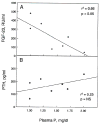FGF-23 and sFRP-4 in chronic kidney disease and post-renal transplantation
- PMID: 16691036
- PMCID: PMC4446726
- DOI: 10.1159/000093277
FGF-23 and sFRP-4 in chronic kidney disease and post-renal transplantation
Abstract
Background: The phosphatonins fibroblast growth factor-23 (FGF-23) and FRP-4 are inhibitors of tubular phosphate reabsorption that may play a role in the hyperphosphatemia associated with chronic kidney disease (CKD) or in the hypophosphatemia associated with renal transplants.
Methods: Plasma FGF-23, FRP-4, phosphorus and parathyroid hormone were measured in patients at all stages of CKD. Phosphate regulation of FGF-23 and secreted frizzled related protein-4 (sFRP-4) was examined in end-stage renal disease patients in the presence and absence of therapeutic phosphate binder usage. In renal transplant patients, plasma FGF-23, sFRP-4 and phosphorus concentrations were determined before and 4-5 days after transplantation.
Results: Plasma FGF-23 correlated with creatinine clearance (r2 = -0.584, p < 0.0001) and plasma phosphorus (r2 = 0.347, p < 0.001) in CKD patients and with plasma phosphorus (r2 = 0.448, p < 0.001) in end-stage renal disease patients. Phosphate binder withdrawal increased FGF-23 levels. In kidney transplant patients, dramatic decreases in FGF-23 (-88.8 +/- 5.4%) and phosphorus (-64 +/- 10.2%) were observed by 4-5 days post-transplantation. In patients with post-transplant hypophosphatemia, FGF-23 levels correlated inversely with plasma phosphorus (r2 = 0.661, p < 0.05). sFRP-4 levels did not change with creatinine clearance or hyperphosphatemia in CKD or end-stage renal disease patients, and no relation was noted between post-transplant sFRP-4 levels and hypophosphatemia.
Conclusions: In CKD, FGF-23 levels rose with decreasing creatinine clearance rates and increasing plasma phosphorus levels, and rapidly decreased post-transplantation suggesting FGF-23 is cleared by the kidney. Residual FGF-23 may contribute to the hypophosphatemia in post-transplant patients.
Figures











Similar articles
-
Mechanisms of renal phosphate loss in liver resection-associated hypophosphatemia.Ann Surg. 2009 May;249(5):824-7. doi: 10.1097/SLA.0b013e3181a3e562. Ann Surg. 2009. PMID: 19387319 Free PMC article.
-
Post-transplant hypophosphatemia: Tertiary 'Hyper-Phosphatoninism'?Kidney Int. 2006 Oct;70(8):1486-94. doi: 10.1038/sj.ki.5001788. Epub 2006 Aug 30. Kidney Int. 2006. PMID: 16941023
-
Tertiary 'hyperphosphatoninism' accentuates hypophosphatemia and suppresses calcitriol levels in renal transplant recipients.Am J Transplant. 2007 May;7(5):1193-200. doi: 10.1111/j.1600-6143.2007.01753.x. Epub 2007 Mar 12. Am J Transplant. 2007. PMID: 17359508 Clinical Trial.
-
Regulation of phosphate homeostasis by the phosphatonins and other novel mediators.Pediatr Nephrol. 2008 Aug;23(8):1203-10. doi: 10.1007/s00467-008-0751-z. Epub 2008 Feb 21. Pediatr Nephrol. 2008. PMID: 18288501 Free PMC article. Review.
-
Tertiary excess of fibroblast growth factor 23 and hypophosphatemia following kidney transplantation.Pediatr Transplant. 2011 Feb;15(1):37-46. doi: 10.1111/j.1399-3046.2010.01405.x. Epub 2010 Oct 8. Pediatr Transplant. 2011. PMID: 20946192 Free PMC article. Review.
Cited by
-
Hyperphosphatemia with elevated serum PTH and FGF23, reduced 1,25(OH)2D and normal FGF7 concentrations characterize patients with CKD.BMC Nephrol. 2021 Mar 30;22(1):114. doi: 10.1186/s12882-021-02311-3. BMC Nephrol. 2021. PMID: 33784965 Free PMC article.
-
Renal Clearance of Mineral Metabolism Biomarkers.J Am Soc Nephrol. 2016 Feb;27(2):392-7. doi: 10.1681/ASN.2014121253. Epub 2015 Jun 5. J Am Soc Nephrol. 2016. PMID: 26047790 Free PMC article.
-
Insights from genetic disorders of phosphate homeostasis.Semin Nephrol. 2013 Mar;33(2):143-57. doi: 10.1016/j.semnephrol.2012.12.015. Semin Nephrol. 2013. PMID: 23465501 Free PMC article. Review.
-
Serum fibroblast growth factor-23 and incident hypertension: the Atherosclerosis Risk in Communities (ARIC) Study.J Hypertens. 2016 Jul;34(7):1266-72. doi: 10.1097/HJH.0000000000000936. J Hypertens. 2016. PMID: 27100793 Free PMC article.
-
Relationship of associated secondary hyperparathyroidism to serum fibroblast growth factor-23 in end stage renal disease: a case-control study.Indian J Endocrinol Metab. 2011 Apr;15(2):105-9. doi: 10.4103/2230-8210.81939. Indian J Endocrinol Metab. 2011. PMID: 21731867 Free PMC article.
References
-
- Pullman TN, Lavender AR, Aho I, Rasmussen H. Direct renal action of a purified parathyroid extract. Endocrinology. 1960;67:570–582. - PubMed
-
- Kurnik BR, Hruska KA. Effects of 1,25 dihydroxycholecalciferol on phosphate transport in Vitamin D deprived rats. Am J Physiol. 1984;247:F 177–184. - PubMed
-
- Kumar R. Vitamin D and the kidney. In: Feldman D, Glorieux FH, Pike JW, editors. Vitamin D (eds) 1. San Diego: Academic Press; 1997. pp. 275–292.
-
- Murer H, Hernando N, Forster I, Biber J. Molecular mechanisms in proximal tubular and small intestinal phosphate reabsorption. Mol Membrane Biol. 2001;18:3–11. - PubMed
-
- Martinez I, Saracho R, Montenegro J, Llach F. The importance of dietary calcium and phosphorus in the secondary hyperparathyroidism of patients with early renal failure. Am J Kidney Dis. 1997;29:496–502. - PubMed
Publication types
MeSH terms
Substances
Grants and funding
LinkOut - more resources
Full Text Sources
Medical
Miscellaneous

